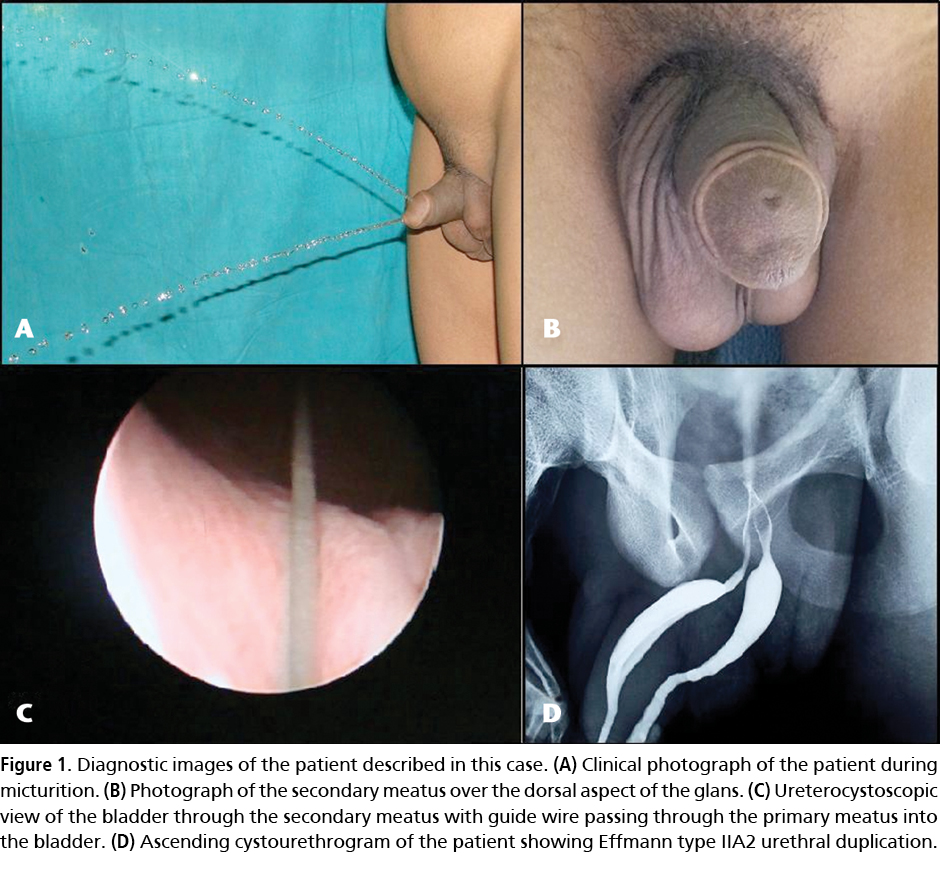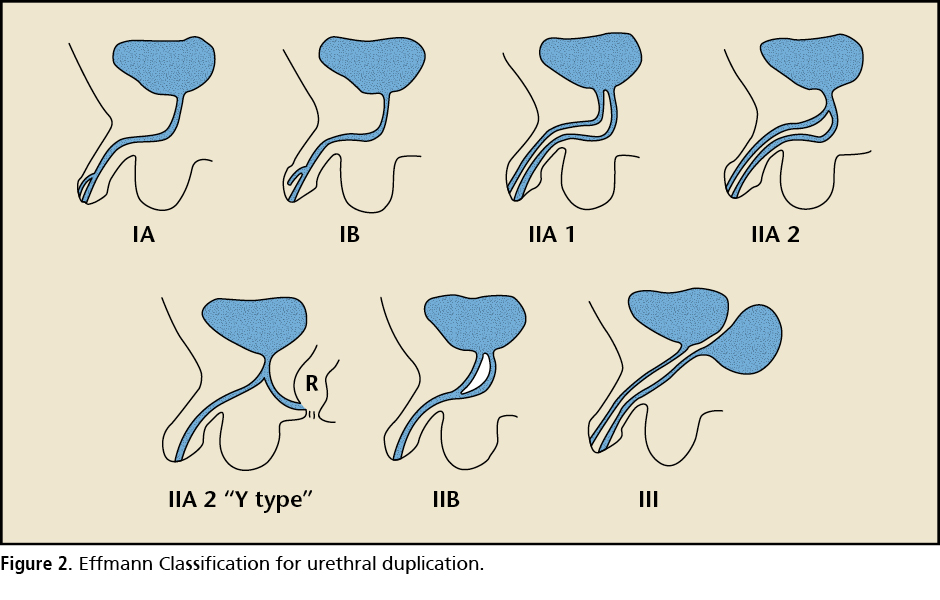Urethral Duplication in a 15-Year-Old: Case Report With Review of the Literature
Mayank Baid, MBBS, MS,1 Arindam Dutta, MS, MCh (Urology)2
1Department of Surgery, Medical College, Kolkata, India; 2Department of Urology, Medical College, Kolkata, India
Urethral duplication is a rare congenital malformation mainly affecting men and boys. Although a number of theories have been proposed to describe this condition, the actual mechanism of this disorder is still not clear. This article highlights a case of urethral duplication in a 15-year-old boy. The malformation was characterized by the presence of continent epispadic and normal apical urethra. Retrograde urethrogram through both urethral tracts simultaneously revealed the malformation as Effmann type IIA2. The patient was not offered surgical intervention as he was asymptomatic and had no problems except for a double stream of urine.
[Rev Urol. 2014;16(3):149-151 doi: 10.3909/riu0618]
© 2014 MedReviews®, LLC
Urethral Duplication in a 15-Year-Old: Case Report With Review of the Literature
Mayank Baid, MBBS, MS,1 Arindam Dutta, MS, MCh (Urology)2
1Department of Surgery, Medical College, Kolkata, India; 2Department of Urology, Medical College, Kolkata, India
Urethral duplication is a rare congenital malformation mainly affecting men and boys. Although a number of theories have been proposed to describe this condition, the actual mechanism of this disorder is still not clear. This article highlights a case of urethral duplication in a 15-year-old boy. The malformation was characterized by the presence of continent epispadic and normal apical urethra. Retrograde urethrogram through both urethral tracts simultaneously revealed the malformation as Effmann type IIA2. The patient was not offered surgical intervention as he was asymptomatic and had no problems except for a double stream of urine.
[Rev Urol. 2014;16(3):149-151 doi: 10.3909/riu0618]
© 2014 MedReviews®, LLC
Urethral Duplication in a 15-Year-Old: Case Report With Review of the Literature
Mayank Baid, MBBS, MS,1 Arindam Dutta, MS, MCh (Urology)2
1Department of Surgery, Medical College, Kolkata, India; 2Department of Urology, Medical College, Kolkata, India
Urethral duplication is a rare congenital malformation mainly affecting men and boys. Although a number of theories have been proposed to describe this condition, the actual mechanism of this disorder is still not clear. This article highlights a case of urethral duplication in a 15-year-old boy. The malformation was characterized by the presence of continent epispadic and normal apical urethra. Retrograde urethrogram through both urethral tracts simultaneously revealed the malformation as Effmann type IIA2. The patient was not offered surgical intervention as he was asymptomatic and had no problems except for a double stream of urine.
[Rev Urol. 2014;16(3):149-151 doi: 10.3909/riu0618]
© 2014 MedReviews®, LLC
Key words
Urethra • Duplication • Malformation • Abnormality
Key words
Urethra • Duplication • Malformation • Abnormality

Urethral duplication is one of the rarest malformations of the urinary tract, with approximately 188 cases described in the literature.

Main Points
• A 15-year-old boy presented with a complaint of life-long double stream of urine.
• All diagnostic testing completed returned normal results, and the patient was entirely asymptomatic, aside from the dual urine stream. Watchful waiting was the chosen course of action.
• This is an extremely rare case, with fewer than 200 documented cases in the literature; based on reported cases, the Effmann Classification system was developed. The most common variant of this anomaly would be the incomplete urethral duplication in the distal location.
Main Points
- A 15-year-old boy presented with a complaint of life-long double stream of urine.
- All diagnostic testing completed returned normal results, and the patient was entirely asymptomatic, aside from the dual urine stream. Watchful waiting was the chosen course of action.
- This is an extremely rare case, with fewer than 200 documented cases in the literature; based on reported cases, the Effmann Classification system was developed. The most common variant of this anomaly would be the incomplete urethral duplication in the distal location.
Urethral duplication is a rare congenital malformation affecting mainly men and boys. Although a number of theories have been proposed to describe this condition, the actual mechanism of this disorder is still not clear.1 We report a case of urethral duplication in a 15-year-old boy.
Case Report
A 15-year-old boy presented with a complaint of a double stream of urine since birth. He had no difficulty with micturition (Figure 1A) There was no history of recurrent urinary tract infection. Both urethras were continent, and there was no complaint of a burning sensation or dribbling of urine during micturition. Physical examination revealed no other associated congenital abnormality. External genitalia were well developed. The penis had a normal meatus at the apex of the glans and a secondary meatus 1 cm proximally on the dorsal aspect of the glans (Figure 1B). Renal ultrasonography revealed both kidneys to be normal. Urethrocystoscopy was done through both urethral tracts, which seemed to be opening directly into bladder (Figure 1C). On inspection, bladder mucosa was normal, and both ureteral openings were also in normal position. Retrograde urethrogram through both tracts simultaneously confirmed a second channel arising from the primary urethra just distal to its junction with the bladder and coursing independently to a second meatus (Effmann type IIA2; Figure 1D). The patient was not offered surgical intervention as he was asymptomatic and had no problems except for a double stream of urine.
Discussion
Urethral duplication is one of the rarest malformations of the urinary tract, with approximately 188 cases described in the literature.2 The anomaly is more common in men and boys, with a few cases reported in women and girls. It may be associated to other changes in the genitourinary tract (such as posterior urethral valve, vesicoureteral reflux, renal dysplasia or agenesis, extrophy of bladder), heart, bowel (imperforate anus, esophageal atresia), and bones.3
Various theories have been proposed for development of urethral duplication, but no single theory explains all the various types of anomalies. Casselman and Williams4 stated that partial failure or an irregularity of the ingrowth of lateral mesoderm between the ectoderm and mesoderm of the cloacal membrane in the midline accounts for the forms with dorsal epispadic channel. Das and Brosman5 suggested that abnormal termination of mullerian duct is responsible for urethral duplication. Rica and colleagues6 reported that asymmetry in the closure of urorectal septum results in urethraperineal fistula.
At the end of third month of embryologic development, urethral folds close as a tube over the urethral plate to form the penile urethra. Any alteration in the sequence would result in double urethral meatus and/or a double urinary stream. Other signs that have been reported are recurrent urinary tract infections, incontinence, vesicoureteral reflux, and perineal dribbling during urination. Patients may also present as urinary tract obstruction or chronic renal insufficiency.
Diagnosis is made during a physical examination, supplemented by voiding cystourethrography, retrograde urethrogram, and urethrocystoscopy.Ultrasound technology aids in diagnosis of other associated anomalies.
The most used classification for urethral duplication is Effmann Classification7 (Figure 2), in which urethral duplication has been divided into three types: type I, incomplete urethral duplication (accessory urethra); type IA, distal; type IB, proximal; type II, complete urethral duplication; type IIA1, two noncommunicating urethras arising independently from bladder and opening in two different meati; type IIA2, a second channel arising from the first and coursing independently to a second meatus; type IIA2 (Y type), when the prostatic urethra splits into two channels with one extending to the glans and the more functional ventral one coursing to the perineum near the rectum; type IIB, two urethras arising from the bladder or posterior urethra and uniting to form a common channel; and type III, urethral duplication associated with duplication of bladder and penis. The most common subtype is type IA. The case reported here is classified as type IIA2.
Most urethral duplications occur in the same sagittal plane and can be divided into either dorsal or ventral. Some more rare duplications occur in the same horizontal plane, which may be associated with duplicated phallus or complete bladder duplication.
Treatment of urethral duplication should be individualized based on the anatomic variant and also clinical symptoms and severity of anomaly. Some patients do not require treatment if they are free from infection and incontinence. Simple accessory duplicated urethras may be fulgurated with a Bugbee™ (Gyrus ACMI, Southborough, MA) electrode and allowed to scar and close. Others need to be excised. If both urethra are functional and end adjacent to each other on the glans, then the septum between the two meatus can be excised to give a single urinary meatus. The most complex Y fistulae may require extensive urethroplasties requiring tissue transfer, such as buccal mucosa grafts.
Injection of a sclerosing agent into the epispadic urethra has been described by Acimi and colleagues,8 but it can cause fibrosis of the corpora cavernosa.
This patient had no history of recurrent urinary tract infection or incontinence. There was no history of dribbling of urine during micturition, and both his kidneys were normal on ultrasonography. He was asymptomatic and had no problem except for double urinary stream. In this case, watchful waiting was the preferred approach.
References
- Erdil H, Mavi A, Erdil S, Gumusburun E. Urethral duplication. Acta Med Okayama. 2003;57:91-93.
- Salle JL, Sibai H, Rosenstein D, et al. Urethral duplication in the male: review of 16 cases. J Urol. 2000;163:1936-1940.
- Woodhouse CR, Williams DI. Duplications of the lower urinary tract in children. Br J Urol. 1979;51:481-487.
- Casselman J, Williams DI. Duplication of the urethra. Acta Urol Belg. 1996;34:535-541.
- Das S, Brosman SA. Duplication of the male urethra. J Urol. 1997;117:452-454.
- Rica PE, Holder TM, Ashcraft KW. Congenital posterior urethral perineal fistula: a case report. J Urol. 1978;199:416-417.
- Effmann EL, Lebowitz RL, Colodny AH. Duplication of the urethra. Radiology. 1976;119:179-185.
- Acimi S, Haouari H, Malah N. [Ureteral duplication in a boy]. Prog Urol. 2003;13:698-699.